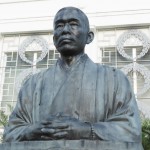1889
The history of the Hongwanji in Hawaii began when Rev. Soryu Kagahi arrived in Honolulu on March 2, 1889 and led services before traveling on to Hilo where he established the first Japanese Buddhist temple in the Hawaiian Islands in April 1889.
1897
In October 1897, Shoi Yamada offered services in a small wooden cottage at Fort and Kukui Streets purchased from Archibald Cleghorn, father of Princess Kaiulani.
1898
The Honpa Hongwanji, under Rev. Satomi Honi, starts Buddhist religious propagation. (Origin of Buddhism in Hawaii, George Yamamoto, 1976)
1899

The first temple on Fort Lane near the current YMCA at Pali & Vineyard.
By December 1899, first Bishop Hoji Satomi and his nephew Rev. Yemyo Imamura, supported by donations from Mary Foster, completed the first Honolulu temple on Fort Lane (near the current site of the YMCA at Pali & Vineyard). The first services were delayed because of the bubonic plague epidemic in Honolulu and the Chinatown district fire.
1900
Until the first services were held on April 1, 1900, the new temple was offered as a relief center for the displaced citizens of Honolulu. This first temple was formally dedicated on November 20, 1900.
1900-1932

A bust of Bishop Imamura on the temple grounds.
Rev. Yemyo Imamura serves as the second Bishop of Honpa Hongwanji Mission of Hawaii. His visionary leadership furthers the process of bringing Shin Buddhism to Hawaii and the Americas.
1901
On May 19, 1901, Queen Liliuokalani attends a service commemorating the birth of Shinran Shonin, accompanied by Mary Foster. The queen’s participation was widely reported at home and abroad and signified a new era of Buddhism in Hawaii.
1918
The current Betsuin Temple main Hondo and basement offices were dedicated in July 1918. The design of the temple, by the architectural firm of Emory and Webb, blended Indian elements—representing the roots of Buddhism, with the Chinese and Japanese features common to Hongwanji temples in Japan, and the western forms representing Jodo Shinshu Buddhism’s future in Hawaii and the Americas.

The new temple blended Indian elements—representing the roots of Buddhism, with the Chinese and Japanese features common to Hongwanji temples in Japan, and the western forms representing Jodo Shinshu Buddhism’s future in Hawaii and the Americas.
The construction took place during the most critical years of World War I; in order to highlight the fact that Japanese Immigrants in Hawaii were loyal Americans, and to facilitate the acceptance of Buddhism as an American faith tradition, wooden pews, a high wooden pulpit, pipe organ, hymnals (gatha books) and Sunday services were instituted along with the traditional Japanese gold and brass altar decorations centered around the priceless, centuries old, image of Amida Buddha.
1936
The Honolulu Hongwanji temple receives the honorary status of “Betsuin,” a direct branch temple of the original Hongwanji in Kyoto, Japan.
1941
The mausoleum/columbarium was added to the mauka end of the main Hondo. The design plans called for wings on either side of the main building to provide office space for the Bishop and the ministers. They were then in basement offices, in space that later was converted to the Betsuin’s current Social Hall.
World War II
Further building is delayed until 1954. During the war, the Betsuin remained under FBI surveillance but no soldier entered the temple and no religious objects were removed. Other temples suffered destruction and ransacking by soldiers.
1964

Front view of the Annex Temple.
The Annex Temple, with a second social hall for the Dharma School and Buddhist Women’s Association (Fujinkai), was dedicated. The ministers’ townhouse complex was also built during this period.
1965
The Hongwanji Mission School breaks ground for a new building to replace the old Japanese High School.
2003
Pacific Buddhist Academy (PBA) is established on the temple campus. PBA is a college-preparatory high school for students of all faiths. Established by the Honpa Hongwanji Mission of Hawaii, PBA is independently administered by its own Board of Directors.







